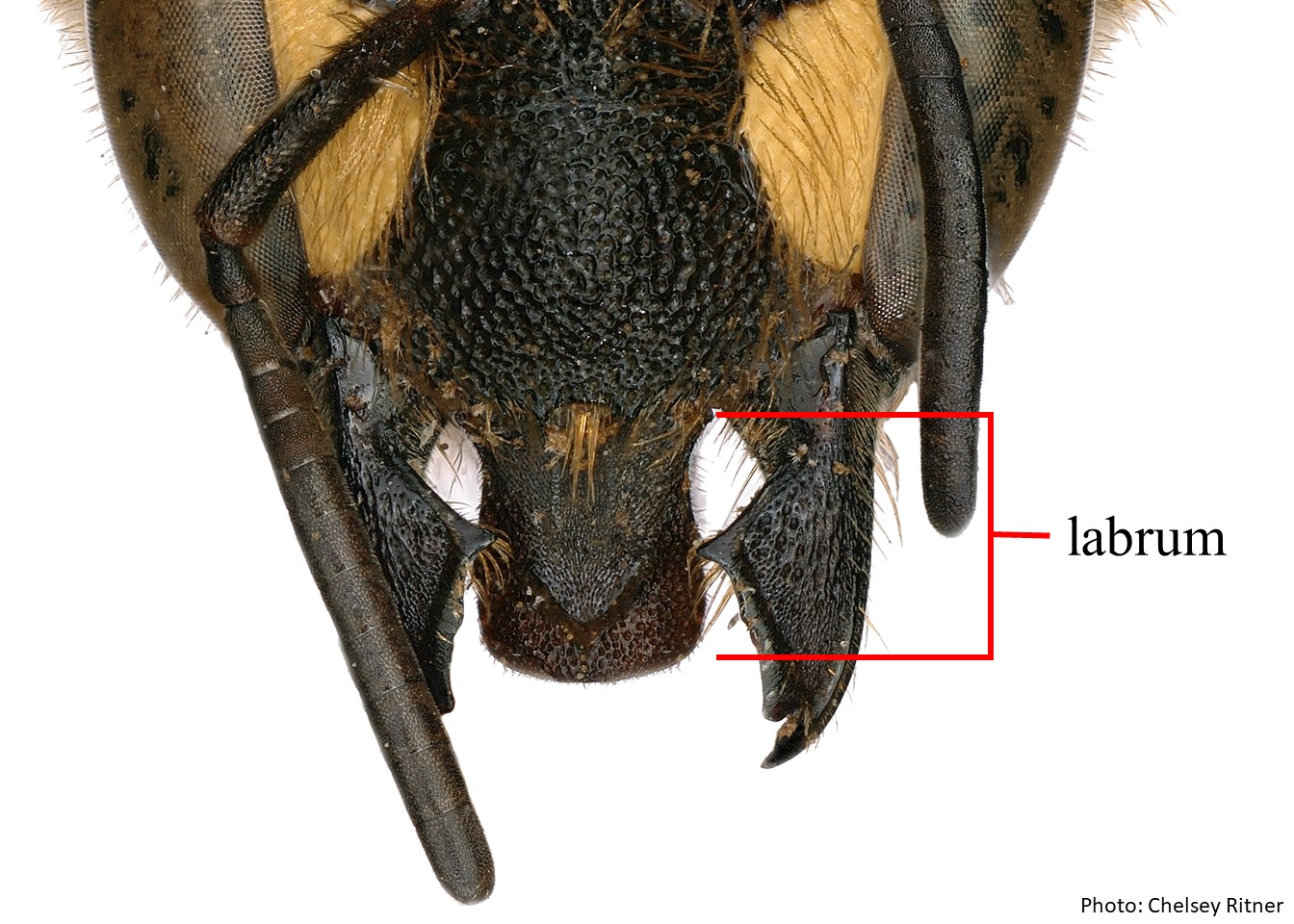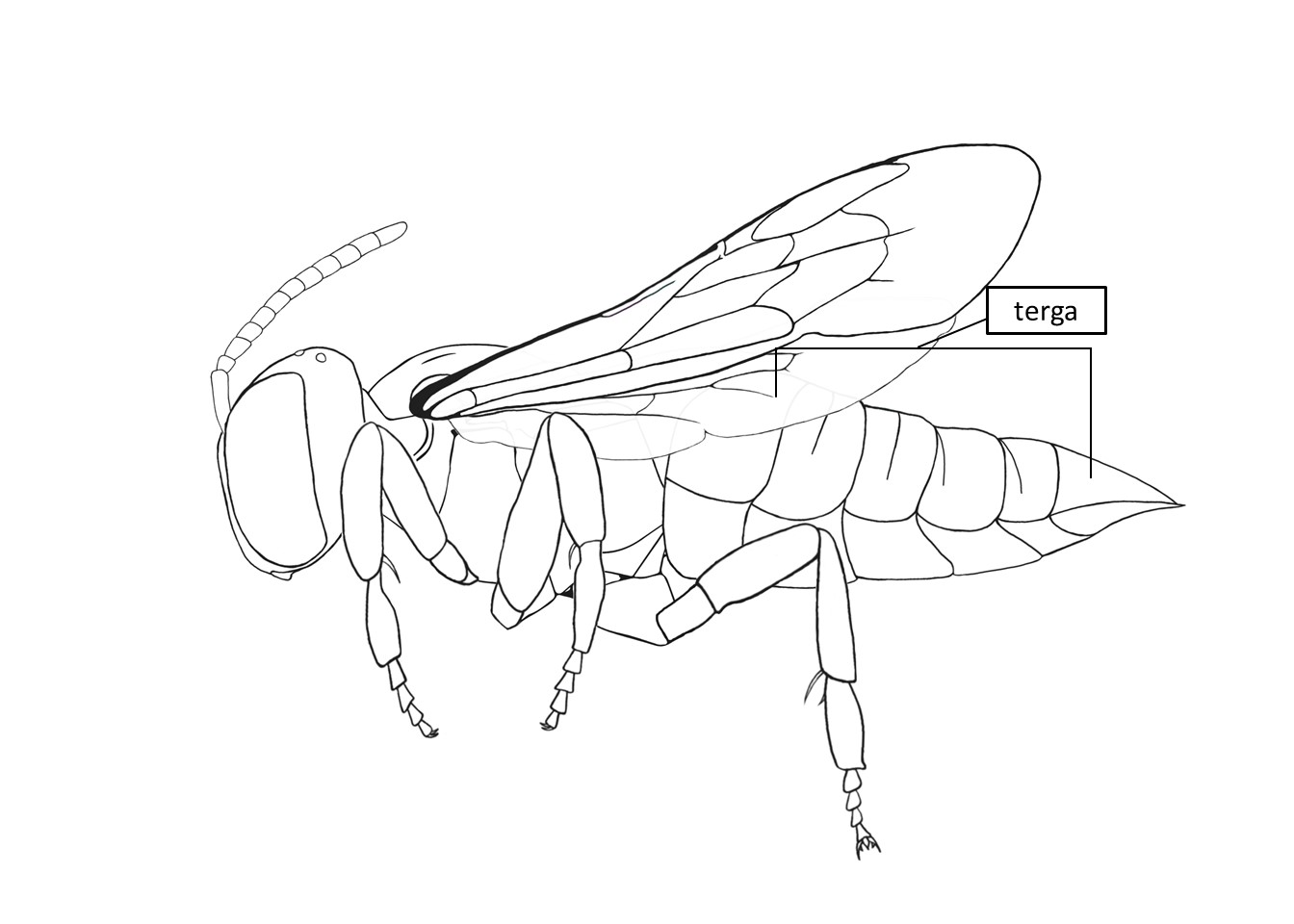Family: Megachilidae
Subfamily: Megachilinae
Tribe: Anthidiini
Genus: Anthidium Fabricius, 1804
Subgenus: A. (Anthidium) Fabricius, 1804
Species: Anthidium cochimi Snelling, 1992
Common name: none
Anthidium (Anthidium) cochimi are dark brown to black with yellow or cream-colored maculations (Gonzalez and Griswold 2013Gonzalez and Griswold 2013:
Gonzalez, V.H. and T.L. Griswold. 2013. Wool carder bees of the genus Anthidium in the Western Hemisphere (Hymenoptera: Megachilidae): diversity, host plant associations, phylogeny, and biogeography. Zoological Journal 168: 221ndash;425.). Females have white pubescencepubescence:
short, fine hair
except for limited yellow to brown hairs on the vertexvertex:
the area between the ocelli and the back of the head, scutumscutum:
the large segment on top of the thorax located between the wings and behind the head
, axillaaxilla:
the triangular or rounded point on the thorax where thoracic muscles meet the forewing of an insect, scutellumscutellum:
shield shaped plate behind scutum, inner tarsitarsi:
the group of segments at the end of the leg following the tibia
, and S6S6:
the plates on the underside of the abdomen, often abbreviated when referring to a specific segment to S1, S2, S3, S4, S5, S6, S7, or S8
 . Females range in body length from 9.5–13.2 mm (Gonzalez and Griswold 2013Gonzalez and Griswold 2013:
. Females range in body length from 9.5–13.2 mm (Gonzalez and Griswold 2013Gonzalez and Griswold 2013:
Gonzalez, V.H. and T.L. Griswold. 2013. Wool carder bees of the genus Anthidium in the Western Hemisphere (Hymenoptera: Megachilidae): diversity, host plant associations, phylogeny, and biogeography. Zoological Journal 168: 221ndash;425.). Males have pale pubescencepubescence:
short, fine hair
on the vertexvertex:
the area between the ocelli and the back of the head, scutumscutum:
the large segment on top of the thorax located between the wings and behind the head
, and scutellumscutellum:
shield shaped plate behind scutum, and range in body length from 15–17.7 mm (Gonzalez and Griswold 2013Gonzalez and Griswold 2013:
Gonzalez, V.H. and T.L. Griswold. 2013. Wool carder bees of the genus Anthidium in the Western Hemisphere (Hymenoptera: Megachilidae): diversity, host plant associations, phylogeny, and biogeography. Zoological Journal 168: 221ndash;425.).
(modified from Gonzalez and Griswold 2013Gonzalez and Griswold 2013:
Gonzalez, V.H. and T.L. Griswold. 2013. Wool carder bees of the genus Anthidium in the Western Hemisphere (Hymenoptera: Megachilidae): diversity, host plant associations, phylogeny, and biogeography. Zoological Journal 168: 221ndash;425.)
 has distinct basalbasal:
has distinct basalbasal: with slightly crenulatecrenulate:
with slightly crenulatecrenulate: with basalbasal:
with basalbasal: lacks a median apicalapical:
lacks a median apicalapical: distaldistal:
distaldistal: is rounded.
is rounded. has a short median apicalapical:
has a short median apicalapical: laterallateral:
laterallateral: median spine.
median spine. laterallateral:
laterallateral:Female A. cochimi may be confused with A. maculifrons due to the presence of T1–T5 with elevated discal areas, and T6T6:
the segments on the top side of the abdomen, often abbreviated when referring to a specific segment to T1, T2, T3, T4, T5, T6, or T7 with crenulatecrenulate:
with crenulatecrenulate:
having a finely scalloped or notched outline or edge
preapical carinacarina:
a clearly defined ridge or keel, not necessarily high or acute; usually appears on bees as simply a raised line
and small, laterallateral:
relating, pertaining, or attached to the side
projections (Gonzalez and Griswold 2013Gonzalez and Griswold 2013:
Gonzalez, V.H. and T.L. Griswold. 2013. Wool carder bees of the genus Anthidium in the Western Hemisphere (Hymenoptera: Megachilidae): diversity, host plant associations, phylogeny, and biogeography. Zoological Journal 168: 221ndash;425.). Female A. cochimi can be differentiated from A. maculifrons by its clypeusclypeus:
a section of the face below the antennae, demarcated by the epistomal sutures with a slightly convexconvex:
curved outward
distal margin and low sublateral tubercles (Gonzalez and Griswold 2013Gonzalez and Griswold 2013:
Gonzalez, V.H. and T.L. Griswold. 2013. Wool carder bees of the genus Anthidium in the Western Hemisphere (Hymenoptera: Megachilidae): diversity, host plant associations, phylogeny, and biogeography. Zoological Journal 168: 221ndash;425.). Additionally, A. cochimi has hooked apicalapical:
near or at the apex or end of any structure
hairs on the discdisc:
a generic term for the middle surface of a plate (usually in reference to an abdominal segment)
of the clypeusclypeus:
a section of the face below the antennae, demarcated by the epistomal sutures and distaldistal:
place on a segment that is furthest from the place of attachment with the body
half of the supraclypeal areasupraclypeal area:
the region of the head between the antennal sockets and clypeus, demarcated on the sides by the subantennal sutures, while A. maculifrons has normal hairs (Gonzalez and Griswold 2013Gonzalez and Griswold 2013:
Gonzalez, V.H. and T.L. Griswold. 2013. Wool carder bees of the genus Anthidium in the Western Hemisphere (Hymenoptera: Megachilidae): diversity, host plant associations, phylogeny, and biogeography. Zoological Journal 168: 221ndash;425.). Male A. cochimi can be differentiated from all other Anthidium by the subtriangular shaped laterallateral:
relating, pertaining, or attached to the side
lobe on T7T7:
the segments on the top side of the abdomen, often abbreviated when referring to a specific segment to T1, T2, T3, T4, T5, T6, or T7 (Gonzalez and Griswold 2013Gonzalez and Griswold 2013:
(Gonzalez and Griswold 2013Gonzalez and Griswold 2013:
Gonzalez, V.H. and T.L. Griswold. 2013. Wool carder bees of the genus Anthidium in the Western Hemisphere (Hymenoptera: Megachilidae): diversity, host plant associations, phylogeny, and biogeography. Zoological Journal 168: 221ndash;425.).
Anthidium cochimi adults have been recorded in flight from March to June and from late September to early November (Gonzalez and Griswold 2013Gonzalez and Griswold 2013:
Gonzalez, V.H. and T.L. Griswold. 2013. Wool carder bees of the genus Anthidium in the Western Hemisphere (Hymenoptera: Megachilidae): diversity, host plant associations, phylogeny, and biogeography. Zoological Journal 168: 221ndash;425.).
Anthidium cochimi is a generalist that has been observed visiting a variety of species within Asteraceae, Fabaceae, and Zygophyllaceae (Gonzalez and Griswold 2013Gonzalez and Griswold 2013:
Gonzalez, V.H. and T.L. Griswold. 2013. Wool carder bees of the genus Anthidium in the Western Hemisphere (Hymenoptera: Megachilidae): diversity, host plant associations, phylogeny, and biogeography. Zoological Journal 168: 221ndash;425.).
Anthidium cochimi may nest in the abandoned nests of Diadasia (Apidae) (Gonzalez and Griswold 2013Gonzalez and Griswold 2013:
Gonzalez, V.H. and T.L. Griswold. 2013. Wool carder bees of the genus Anthidium in the Western Hemisphere (Hymenoptera: Megachilidae): diversity, host plant associations, phylogeny, and biogeography. Zoological Journal 168: 221ndash;425.).
Anthidium cochimi occur throughout southern Arizona, southern New Mexico, and Texas within the U.S. (Gonzalez and Griswold 2013Gonzalez and Griswold 2013:
Gonzalez, V.H. and T.L. Griswold. 2013. Wool carder bees of the genus Anthidium in the Western Hemisphere (Hymenoptera: Megachilidae): diversity, host plant associations, phylogeny, and biogeography. Zoological Journal 168: 221ndash;425.; Discover Life 2018Discover Life 2018:
Discover Life. 2018. Anthidium (Gulanthidium) . Discover Life. https://www.discoverlife.org/mp/20p?see=Gulanthidiumamp;name=Anthidiumamp;flags=subgenus:amp;mobile=1). In Mexico, they are found in Baja California Sur, Baja California, Sonora, Durango, Coahuila, and Guanajuato. They are native to Baja California, the Sonoran and Chihuahuan deserts, the Gulf of California, and San Lucan xericxeric:
a very dry habitat
scrub landscapes (Gonzalez and Griswold 2013Gonzalez and Griswold 2013:
Gonzalez, V.H. and T.L. Griswold. 2013. Wool carder bees of the genus Anthidium in the Western Hemisphere (Hymenoptera: Megachilidae): diversity, host plant associations, phylogeny, and biogeography. Zoological Journal 168: 221ndash;425.).
Distribution map generated by Discover Life -- click on map for details, credits, and terms of use.
Gonzalez, V.H. and T.L. Griswold. 2013. Wool carder bees of the genus Anthidium in the Western Hemisphere (Hymenoptera: Megachilidae): diversity, host plant associations, phylogeny, and biogeography. Zoological Journal of the Linnean Society 168: 221-425.